
11-1
Chapter 11 Test Bank KEY
D. will produce more output than its rival firms. AACSB: Reflective Thinking
Accessibility: Keyboard Navigation
Blooms: Remember
Difficulty: 1 Easy
Learning Objective: 11-01 Explain the issues regarding measuring the pure union wage advantage and summarize the empirical evidence.
Topic: The Union Wage Advantage
D. there is a distinct "shock effect." AACSB: Reflective Thinking
Accessibility: Keyboard Navigation
Blooms: Remember
Difficulty: 1 Easy
Learning Objective: 11-01 Explain the issues regarding measuring the pure union wage advantage and summarize the empirical evidence.
Topic: The Union Wage Advantage
D. could be explained by the fact that unionized firms are typically smaller. AACSB: Reflective Thinking
Accessibility: Keyboard Navigation
Blooms: Understand
Difficulty: 2 Medium
Learning Objective: 11-01 Explain the issues regarding measuring the pure union wage advantage and summarize the empirical evidence.
Topic: The Union Wage Advantage
4. If Wu is the union wage and Wn is the nonunion wage, the pure union wage advantage is
AACSB: Reflective Thinking
Blooms: Remember

Difficulty: 1 Easy
Learning Objective: 11-01 Explain the issues regarding measuring the pure union wage advantage and summarize the empirical evidence.
Topic: The Union Wage Advantage
5. If union workers in a given occupation are paid $20 per hour while nonunion workers receive $16 per
D. More information is required. AACSB: Reflective Thinking
Accessibility: Keyboard Navigation
Blooms: Understand
Difficulty: 2 Medium
Learning Objective: 11-01 Explain the issues regarding measuring the pure union wage advantage and summarize the empirical evidence.
Topic: The Union Wage Advantage
6. If nonunion workers in a given occupation are paid $16 per hour while union workers receive $20 per
D. More information is required. AACSB: Reflective Thinking
Accessibility: Keyboard Navigation
Blooms: Understand
Difficulty: 2 Medium
Learning Objective: 11-01 Explain the issues regarding measuring the pure union wage advantage and summarize the empirical evidence.
Topic: The Union Wage Advantage
D. compensating wage differential effect. AACSB: Reflective Thinking
Accessibility: Keyboard Navigation
Blooms: Remember
Difficulty: 1 Easy
Learning Objective: 11-01 Explain the issues regarding measuring the pure union wage advantage and summarize the empirical evidence.
Topic: The Union Wage Advantage
D. compensating wage differential effect. AACSB: Reflective Thinking
Accessibility: Keyboard Navigation
Blooms: Remember
Difficulty: 1 Easy
Learning Objective: 11-01 Explain the issues regarding measuring the pure union wage advantage and summarize the empirical evidence.
Topic: The Union Wage Advantage

11-3
AACSB: Reflective Thinking
Accessibility: Keyboard Navigation
Blooms: Remember
Difficulty: 1 Easy
Learning Objective: 11-01 Explain the issues regarding measuring the pure union wage advantage and summarize the empirical evidence.
Topic: The Union Wage Advantage
10. Suppose the union wage rate rises. The "spillover effect" suggests that the nonunion wage rate should
_____ the "threat effect" suggests that the nonunion wage rate should _____.
AACSB: Reflective Thinking
Accessibility: Keyboard Navigation
Blooms: Remember
Difficulty: 1 Easy
Learning Objective: 11-01 Explain the issues regarding measuring the pure union wage advantage and summarize the empirical evidence.
Topic: The Union Wage Advantage
11. "The union wage advantage is understated because nonunion wages rise as consumer demand shifts
D. threat effect. AACSB: Reflective Thinking
Accessibility: Keyboard Navigation
Blooms: Remember
Difficulty: 1 Easy
Learning Objective: 11-01 Explain the issues regarding measuring the pure union wage advantage and summarize the empirical evidence.
Topic: The Union Wage Advantage
12. Refer to the following diagram. Wages in both the union and nonunion sectors are initially $10. The
union then negotiates a wage rate of $12. The post-negotiation nonunion wage is not yet known.
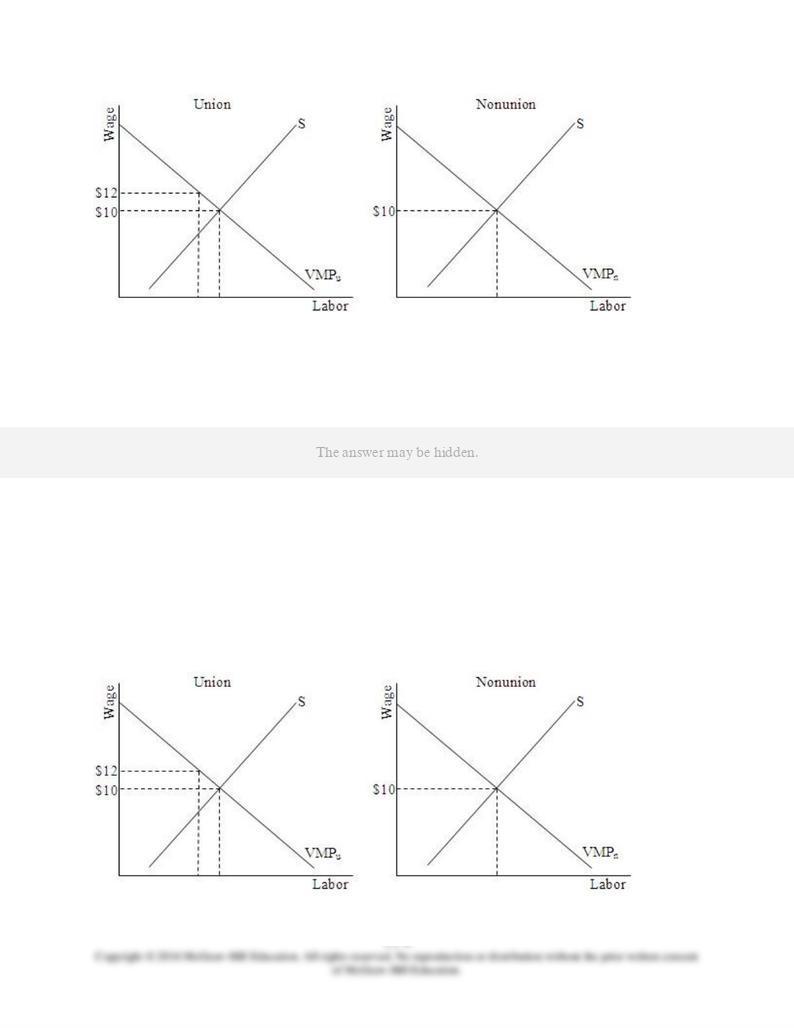
11-4
The pure union wage advantage in this market is
D. More information is needed. AACSB: Reflective Thinking
Blooms: Understand
Difficulty: 2 Medium
Learning Objective: 11-01 Explain the issues regarding measuring the pure union wage advantage and summarize the empirical evidence.
Topic: The Union Wage Advantage
13. Refer to the following diagram. Wages in both the union and nonunion sectors are initially $10. The
union then negotiates a wage rate of $12. The post-negotiation nonunion wage is not yet known.
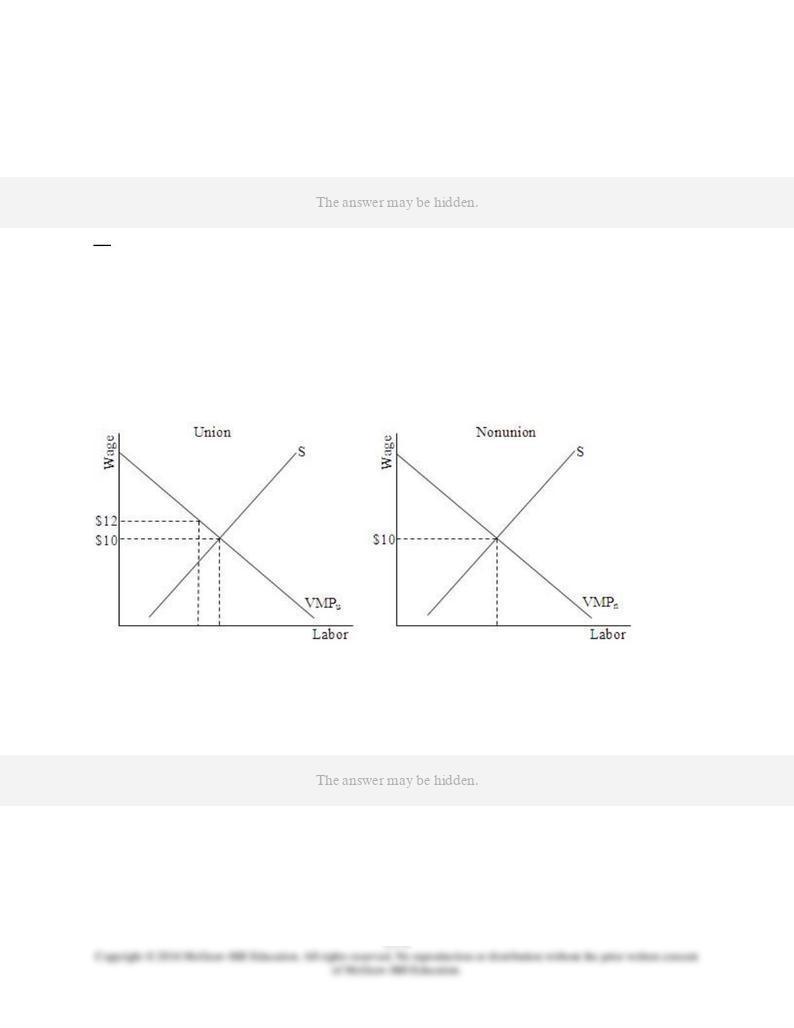
11-5
The measured union wage advantage in this market is
D. More information is needed. AACSB: Reflective Thinking
Blooms: Understand
Difficulty: 2 Medium
Learning Objective: 11-01 Explain the issues regarding measuring the pure union wage advantage and summarize the empirical evidence.
Topic: The Union Wage Advantage
14. Refer to the following diagram. Wages in both the union and nonunion sectors are initially $10. The
union then negotiates a wage rate of $12. The post-negotiation nonunion wage is not yet known.
The product-market effect would be modeled by shifting the
D. union supply curve to the right, reducing the pure union wage advantage. AACSB: Reflective Thinking
Blooms: Understand
Difficulty: 2 Medium
Learning Objective: 11-01 Explain the issues regarding measuring the pure union wage advantage and summarize the empirical evidence.
Topic: The Union Wage Advantage
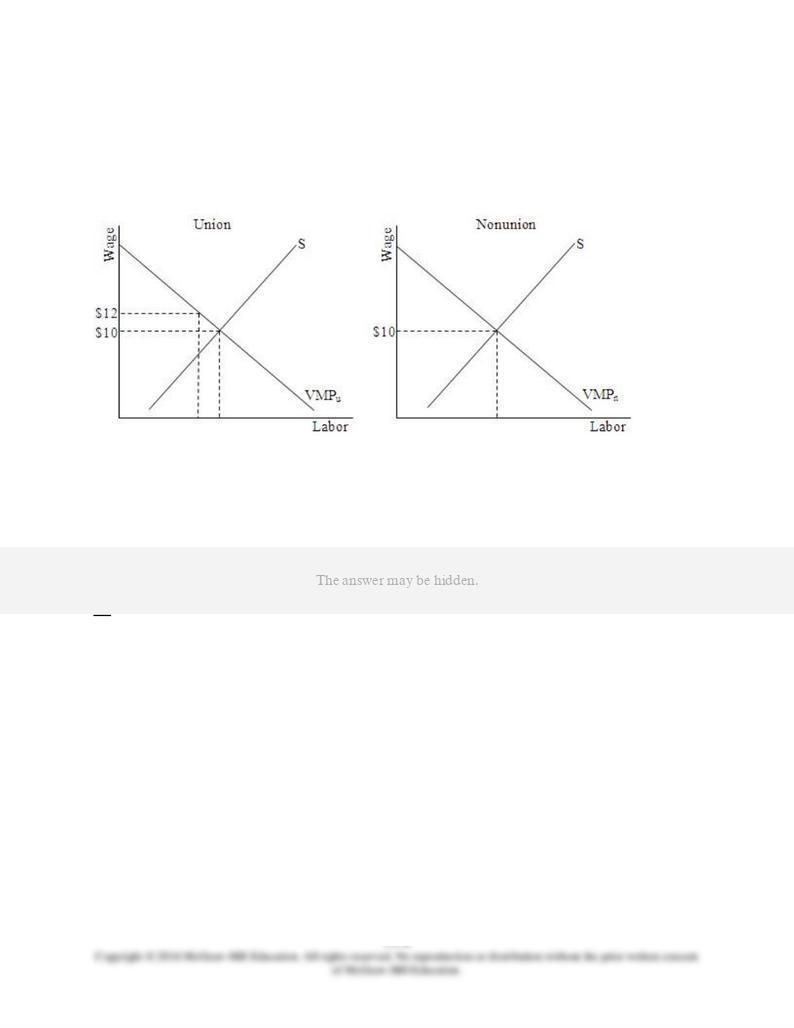
11-6
15. Refer to the following diagram. Wages in both the union and nonunion sectors are initially $10. The
union then negotiates a wage rate of $12. The post-negotiation nonunion wage is not yet known.
The threat effect would be modeled by
AACSB: Reflective Thinking
Blooms: Understand
Difficulty: 2 Medium
Learning Objective: 11-01 Explain the issues regarding measuring the pure union wage advantage and summarize the empirical evidence.
Topic: The Union Wage Advantage
16. Refer to the following diagram. Wages in both the union and nonunion sectors are initially $10. The
union then negotiates a wage rate of $12. The post-negotiation nonunion wage is not yet known.
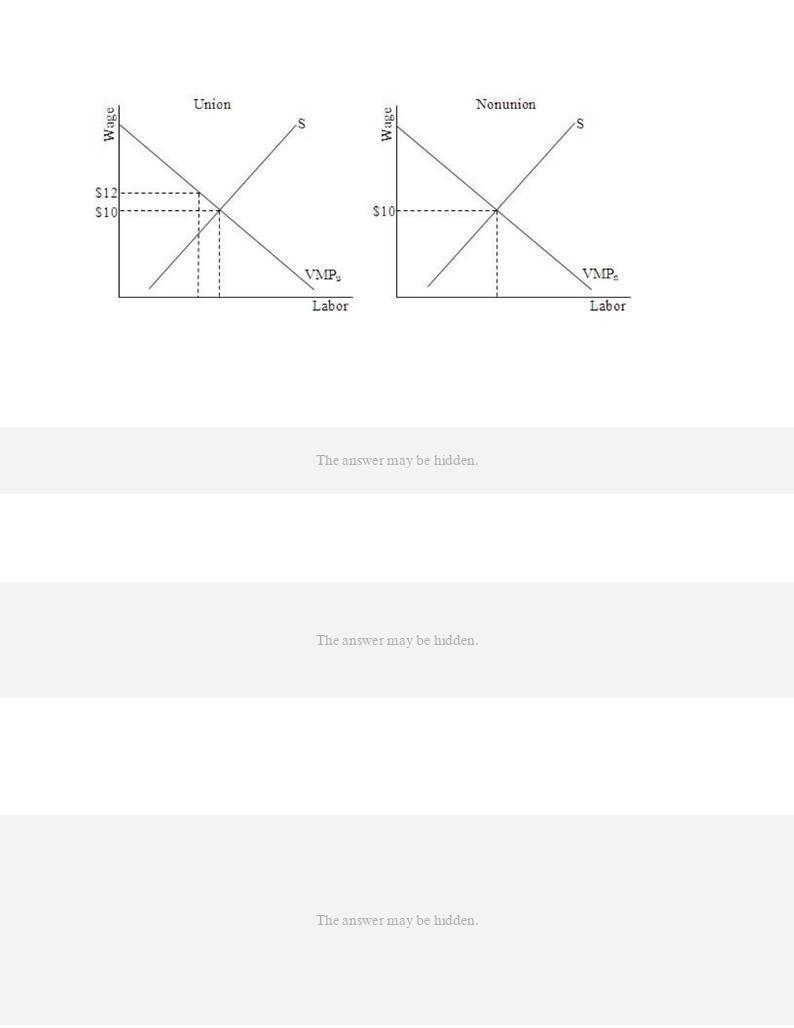
The spillover effect would be modeled by
AACSB: Reflective Thinking
Blooms: Understand
Difficulty: 2 Medium
Learning Objective: 11-01 Explain the issues regarding measuring the pure union wage advantage and summarize the empirical evidence.
Topic: The Union Wage Advantage
gains are much smaller. AACSB: Reflective Thinking
Accessibility: Keyboard Navigation
Blooms: Understand
Difficulty: 2 Medium
Learning Objective: 11-01 Explain the issues regarding measuring the pure union wage advantage and summarize the empirical evidence.
Topic: The Union Wage Advantage

D. unionized plants tend to be less efficient, resulting in lower marginal products of union workers.
AACSB: Reflective Thinking
Accessibility: Keyboard Navigation
Blooms: Understand
Difficulty: 2 Medium
Learning Objective: 11-01 Explain the issues regarding measuring the pure union wage advantage and summarize the empirical evidence.
Topic: The Union Wage Advantage
D. 28%. AACSB: Reflective Thinking
Accessibility: Keyboard Navigation
Blooms: Remember
Difficulty: 1 Easy
Learning Objective: 11-01 Explain the issues regarding measuring the pure union wage advantage and summarize the empirical evidence.
Topic: The Union Wage Advantage
20. Empirical research suggests that the union wage advantage in the public sector, compared to the
D. the same. AACSB: Reflective Thinking
Accessibility: Keyboard Navigation
Blooms: Remember
Difficulty: 1 Easy
Learning Objective: 11-01 Explain the issues regarding measuring the pure union wage advantage and summarize the empirical evidence.
Topic: The Union Wage Advantage
21. The union wage advantage
AACSB: Reflective Thinking
Accessibility: Keyboard Navigation
Blooms: Remember
Difficulty: 1 Easy
Learning Objective: 11-01 Explain the issues regarding measuring the pure union wage advantage and summarize the empirical evidence.
Topic: The Union Wage Advantage

11-9
AACSB: Reflective Thinking
Accessibility: Keyboard Navigation
Blooms: Remember
Difficulty: 1 Easy
Learning Objective: 11-01 Explain the issues regarding measuring the pure union wage advantage and summarize the empirical evidence.
Topic: The Union Wage Advantage
23. The union wage advantage tends to
A. decrease during recessions.
B. be smaller among lower-educated workers.
C. be smaller among African Americans.
D. be larger among craft unions. AACSB: Reflective Thinking
Accessibility: Keyboard Navigation
Blooms: Remember
Difficulty: 1 Easy
Learning Objective: 11-01 Explain the issues regarding measuring the pure union wage advantage and summarize the empirical evidence.
Topic: The Union Wage Advantage
A. The union wage advantage narrows during recessions.
B. There is no union wage advantage for African American males.
C. Unions achieve bigger wage gains for clerical workers than workers in crafts.
D. The union wage advantage is bigger for workers with less education than for workers with more
education. AACSB: Reflective Thinking
Accessibility: Keyboard Navigation
Blooms: Remember
Difficulty: 1 Easy
Learning Objective: 11-01 Explain the issues regarding measuring the pure union wage advantage and summarize the empirical evidence.
Topic: The Union Wage Advantage
25. Which one of the following does not help to explain why union workers receive more fringe benefits
than nonunion workers?
A. The unionized firm is willing to pay both higher wages and fringe benefits to avoid the costs of a
strike.
B. The higher incomes of union workers allow them to "purchase" more fringe benefits.
C. Unions are primarily composed of younger workers who have more to gain from long-term
compensation such as the kind provided by union pension plans.
D. As collective voice institutions, unions may better formulate fringe benefit proposals, inform their
membership of their worth, and communicate these desires to the firm. AACSB: Reflective Thinking
Accessibility: Keyboard Navigation
Blooms: Understand
Difficulty: 2 Medium
Learning Objective: 11-01 Explain the issues regarding measuring the pure union wage advantage and summarize the empirical evidence.
Topic: The Union Wage Advantage
26. Unions may reduce economic efficiency by
A. providing an "exit" mechanism.
B. insisting promotions be based on ability rather than seniority.
C. imposing restrictive work rules.
D. reducing worker turnover. AACSB: Reflective Thinking
Accessibility: Keyboard Navigation
Blooms: Remember
Difficulty: 1 Easy
Learning Objective: 11-02 Explain the ways by which unions may affect productivity and allocative efficiency and summarize the empirical
evidence.

11-10
Topic: The Union Wage Advantage
27. Unions may increase economic efficiency by
A. providing an "exit" mechanism.
B. insisting promotions be based on ability rather than seniority.
C. imposing restrictive work rules.
D. reducing worker turnover. AACSB: Reflective Thinking
Accessibility: Keyboard Navigation
Blooms: Remember
Difficulty: 1 Easy
Learning Objective: 11-02 Explain the ways by which unions may affect productivity and allocative efficiency and summarize the empirical
evidence.
Topic: Efficiency and Productivity
28. Unions may increase productivity by
A. providing a "voice mechanism."
B. providing an "exit mechanism."
C. reducing the capital/labor ratio.
D. increasing worker turnover, particularly among younger workers, so that only the best employees
survive. AACSB: Reflective Thinking
Accessibility: Keyboard Navigation
Blooms: Remember
Difficulty: 1 Easy
Learning Objective: 11-02 Explain the ways by which unions may affect productivity and allocative efficiency and summarize the empirical
evidence.
Topic: Efficiency and Productivity
29. By reducing labor turnover, unions may increase productivity because a lower turnover rate
A. results in a less-experienced workforce.
B. increases the incentive for firms to provide specific training to their workers.
C. allows firms to employ a greater number of younger, more energetic workers.
D. increases the incentive for firms to substitute labor for capital in the production process.
AACSB: Reflective Thinking
Accessibility: Keyboard Navigation
Blooms: Remember
Difficulty: 1 Easy
Learning Objective: 11-02 Explain the ways by which unions may affect productivity and allocative efficiency and summarize the empirical
evidence.
Topic: Efficiency and Productivity
30. Which one of the following observations supports the argument that unions increase productivity?
A. Turnover in union firms is lower than in nonunion firms.
B. Unions alter the allocation of labor between union and nonunion firms.
C. Training at union firms is lower than at nonunion firms.
D. Unions provide an "exit" option, whereas nonunion workers only have a "voice" option.
AACSB: Reflective Thinking
Accessibility: Keyboard Navigation
Blooms: Understand
Difficulty: 2 Medium
Learning Objective: 11-02 Explain the ways by which unions may affect productivity and allocative efficiency and summarize the empirical
evidence.
Topic: Efficiency and Productivity
31. As a percentage of total work-time, the average amount of work-time lost because of strikes annually
is typically

11-11
A. less than 1%.
B. 4%–5%.
C. 9%–10%.
D. greater than 15%.
AACSB: Reflective Thinking
Accessibility: Keyboard Navigation
Blooms: Remember
Difficulty: 1 Easy
Learning Objective: 11-02 Explain the ways by which unions may affect productivity and allocative efficiency and summarize the empirical
evidence.
Topic: Efficiency and Productivity
32. Compared to other industrial countries, such as Canada, France, Italy, and the United Kingdom, the
incidence of strikes in the United States is
A. approximately the sam
B. slightly higher.
C. significantly lower.
D. significantly higher. AACSB: Reflective Thinking
Accessibility: Keyboard Navigation
Blooms: Remember
Difficulty: 1 Easy
Learning Objective: 11-02 Explain the ways by which unions may affect productivity and allocative efficiency and summarize the empirical
evidence.
Topic: Efficiency and Productivity
33. Work-time lost as a result of a strike
A. is generally less costly in service industries than in durable-goods industries.
B. is estimated to be more costly than the efficiency losses resulting from union-caused labor
misallocation.
C. may overstate the cost of a strike if struck employers are able to expand their inventories in
anticipation of the strike.
D. may understate the cost of a strike if the work stoppage disrupts production in associated industries.
AACSB: Reflective Thinking
Accessibility: Keyboard Navigation
Blooms: Remember
Difficulty: 1 Easy
Learning Objective: 11-02 Explain the ways by which unions may affect productivity and allocative efficiency and summarize the empirical
evidence.
Topic: Efficiency and Productivity
34. The adverse effects of a strike on other associated industries and consumers are likely to be
A. greater when it involves products rather than services.
B. greater when it involves small firms rather than large firms.
C. on the order of 5% of GDP each year.
D. substantially less than the adverse effects of lockouts by management. AACSB: Reflective Thinking
Accessibility: Keyboard Navigation
Blooms: Remember
Difficulty: 1 Easy
Learning Objective: 11-02 Explain the ways by which unions may affect productivity and allocative efficiency and summarize the empirical
evidence.
Topic: Efficiency and Productivity
35. The allocative efficiency loss associated with unions arises because

11-12
A. job losers in the union sector take away jobs from more productive workers in the nonunion sector.
B. the value of lost output in the union sector is greater than the value of any additional output in the
nonunion sector.
36. Refer to the following graph, in which all product markets are assumed to be competitive.
Assume the two labor demand curves are identical and that all union workers who lose their job as a
result of the union wage increase from Wn to Wu find jobs in the nonunion sector. The area corresponding
to the efficiency loss is
D. gcdh. AACSB: Analytic
Blooms: Apply
Difficulty: 3 Hard
Learning Objective: 11-02 Explain the ways by which unions may affect productivity and allocative efficiency and summarize the empirical
evidence.
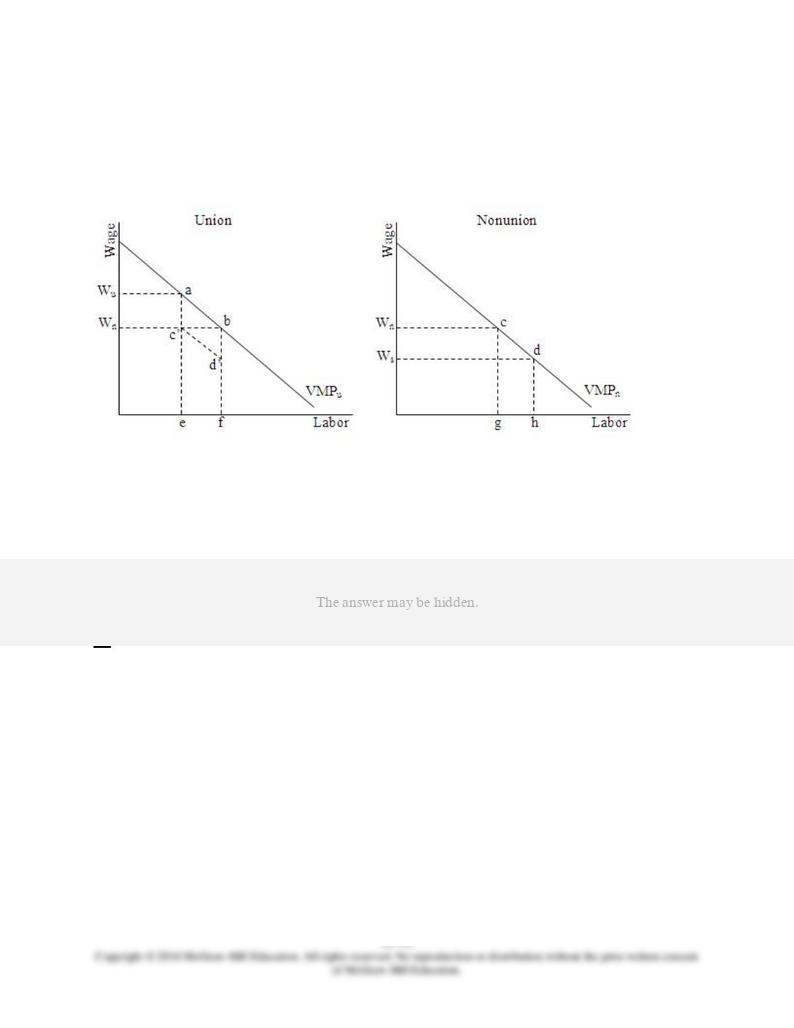
11-13
Topic: Efficiency and Productivity
37. Refer to the following graph, in which all product markets are assumed to be competitive.
If all displaced union workers opt to remain in the union sector hoping to be recalled, the area
corresponding to the efficiency loss of the union wage increase is
D. gcdh. AACSB: Analytic
Blooms: Apply
Difficulty: 3 Hard
Learning Objective: 11-02 Explain the ways by which unions may affect productivity and allocative efficiency and summarize the empirical
evidence.
Topic: Efficiency and Productivity
38. Refer to the following graph, in which all product markets are assumed to be competitive.
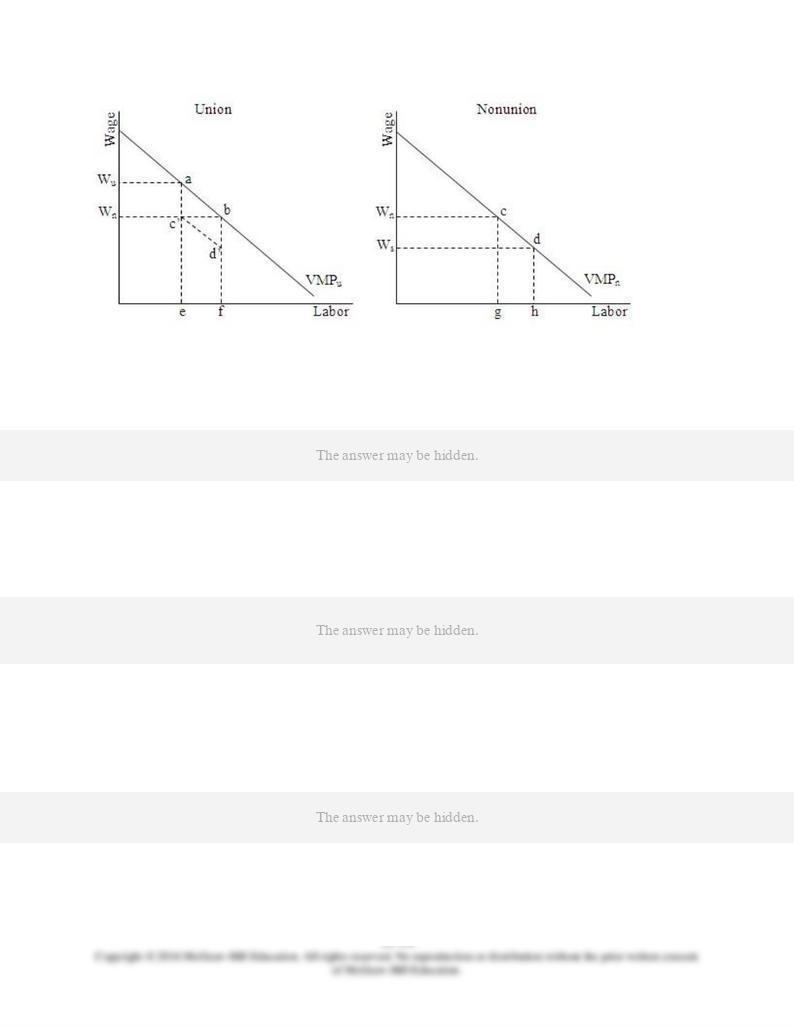
11-14
The allocative efficiency loss implied by the diagram is a static, short-run loss. Compared to the static
loss, the dynamic, long-run loss is probably
D. smaller, because the decline in nonunion wages increases the extent of poverty. AACSB: Analytic
Blooms: Apply
Difficulty: 3 Hard
Learning Objective: 11-02 Explain the ways by which unions may affect productivity and allocative efficiency and summarize the empirical
evidence.
Topic: Efficiency and Productivity
AACSB: Reflective Thinking
Accessibility: Keyboard Navigation
Blooms: Understand
Difficulty: 2 Medium
Learning Objective: 11-02 Explain the ways by which unions may affect productivity and allocative efficiency and summarize the empirical
evidence.
Topic: Efficiency and Productivity
40. In industry A, all displaced workers remain in the union sector waiting to be recalled. In industry B,
D. dynamic efficiency loss is greater in industry A. AACSB: Reflective Thinking
Accessibility: Keyboard Navigation
Blooms: Understand
Difficulty: 2 Medium
Learning Objective: 11-02 Explain the ways by which unions may affect productivity and allocative efficiency and summarize the empirical

11-15
evidence.
Topic: Efficiency and Productivity
41. All of the following suggest that unions may improve productivity and efficiency except:
A. unions provide workers a voice with which to communicate to management.
B. union wage pressure may force management to adopt more efficient techniques to maintain
profitability.
C. union workers protected by seniority rules are more likely to pass on knowledge to new workers.
D. unionization increases turnover rates, bringing in new workers with fresh ideas. AACSB: Reflective Thinking
Accessibility: Keyboard Navigation
Blooms: Understand
Difficulty: 2 Medium
Learning Objective: 11-02 Explain the ways by which unions may affect productivity and allocative efficiency and summarize the empirical
evidence.
Topic: Efficiency and Productivity
42. Regarding unions and productivity, empirical results show that
A. the impact of unionization on productivity is not clear cut.
B. unionization reduces productivity generally.
C. unionization improves productivity generally.
D. unionization improves productivity most in industries where union and management are most
adversarial. AACSB: Reflective Thinking
Accessibility: Keyboard Navigation
Blooms: Remember
Difficulty: 1 Easy
Learning Objective: 11-02 Explain the ways by which unions may affect productivity and allocative efficiency and summarize the empirical
evidence.
Topic: Efficiency and Productivity
43. Which of the following statements is supported by empirical evidence?
A. Lower productivity growth for unionized firms is primarily due to these firms being in industries with
slow productivity growth.
B. The negative impact of unions on productivity is greatest in industries that are most competitive.
C. The positive impact of unions on productivity is greatest in industries where the union wage advantage
is smallest.
D. Unions indirectly improve productivity growth by increasing the rate of investment in physical capital.
AACSB: Reflective Thinking
Accessibility: Keyboard Navigation
Blooms: Remember
Difficulty: 1 Easy
Learning Objective: 11-02 Explain the ways by which unions may affect productivity and allocative efficiency and summarize the empirical
evidence.
Topic: Efficiency and Productivity
44. Empirical estimates generally show that unions reduce
A. both firm profitability and economic efficiency.
B. firm profitability but improve economic efficiency.
C. firm profitability, but there is no consensus regarding their effects on economic efficiency.
D. economic efficiency, but there is no consensus regarding their effects on firm profitability.
AACSB: Reflective Thinking
Accessibility: Keyboard Navigation
Blooms: Remember
Difficulty: 1 Easy
Learning Objective: 11-03 Describe the effects of unionism on firm profitability.
Topic: Firm Productivity
45. Evidence indicates that, on balance, union wage policies tend to

A. lead to greater overall inequality in the distribution of earnings.
B. assign wages to individual workers, whereas nonunion firms tend to assign wages to jobs.
D. union wage determination is not a serious cause of inflation in the United States. AACSB: Reflective Thinking
Accessibility: Keyboard Navigation
Blooms: Remember
Difficulty: 1 Easy
Learning Objective: 11-05 Assess the impact of unions on inflation, employment, unemployment, and the share of national income paid as wages.
Topic: Other Issues: Inflation, Unemployment, and Income Shares
D. had a negligible effect on labor’s share. AACSB: Reflective Thinking
Accessibility: Keyboard Navigation
Blooms: Remember
Difficulty: 1 Easy
Learning Objective: 11-05 Assess the impact of unions on inflation, employment, unemployment, and the share of national income paid as wages.
Topic: Other Issues: Inflation, Unemployment, and Income Shares
48. Which of the following best describes the events following the deregulation of the trucking and airline
D. Employment fell in both industries, while wages increased. AACSB: Reflective Thinking
Accessibility: Keyboard Navigation
Blooms: Remember
Difficulty: 1 Easy
Learning Objective: 11-01 Explain the issues regarding measuring the pure union wage advantage and summarize the empirical evidence.
Topic: The Union Wage Advantage
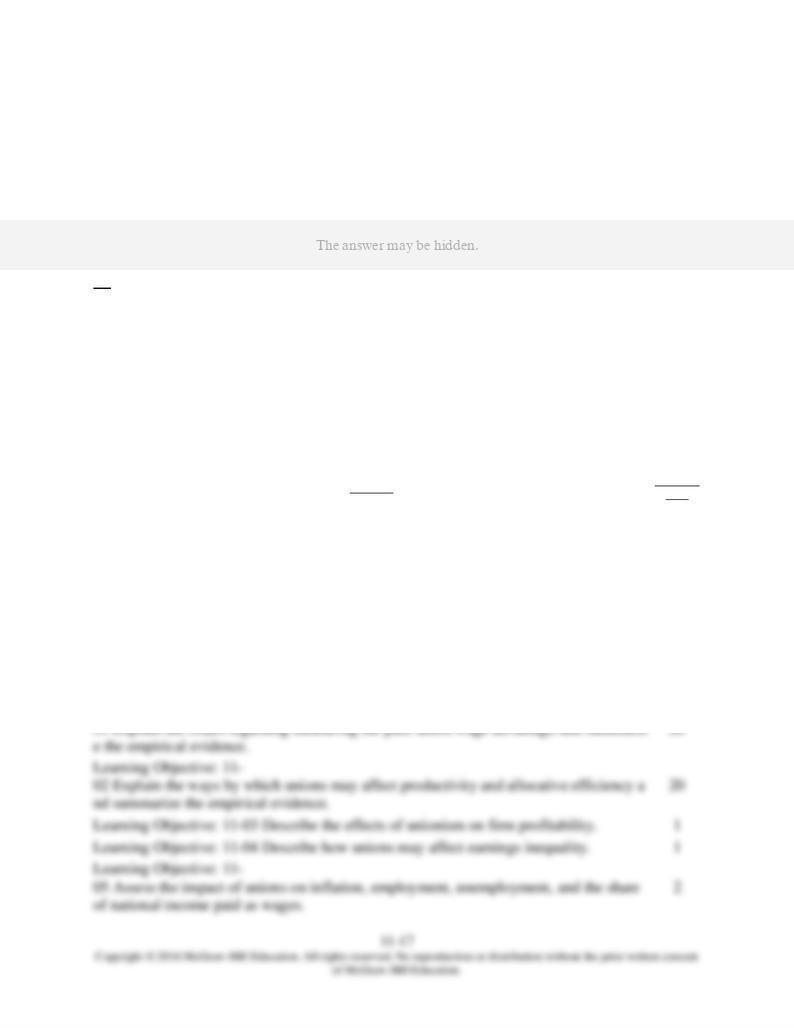
AACSB: Reflective Thinking
Accessibility: Keyboard Navigation
Blooms: Remember
Difficulty: 1 Easy
Learning Objective: 11-02 Explain the ways by which unions may affect productivity and allocative efficiency and summarize the empirical
evidence.
Topic: Efficiency and Productivity
50. Fallick and Hassett suggest that the tendency of union firms to merge with union firms can be
D. union certification elections reduce firms? rates of investment in physical capital. AACSB: Reflective Thinking
Accessibility: Keyboard Navigation
Blooms: Remember
Difficulty: 1 Easy
Learning Objective: 11-02 Explain the ways by which unions may affect productivity and allocative efficiency and summarize the empirical
evidence.
Topic: Efficiency and Productivity
Chapter 11 Test Bank Summary
Category
# of Ques
tions
AACSB: Analytic
3
AACSB: Reflective Thinking
47
Accessibility: Keyboard Navigation
41
Blooms: Apply
3
Blooms: Remember
32
Blooms: Understand
15
Difficulty: 1 Easy
32
Difficulty: 2 Medium
15
Difficulty: 3 Hard
3
Learning Objective: 11-

Topic: Distribution of Earnings
1